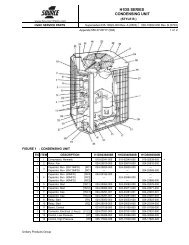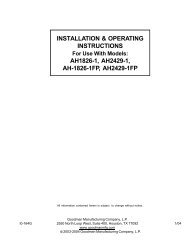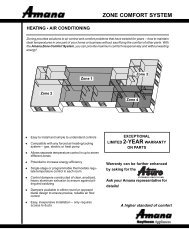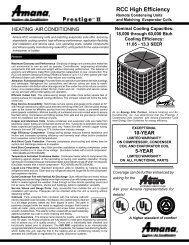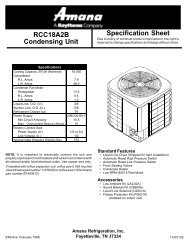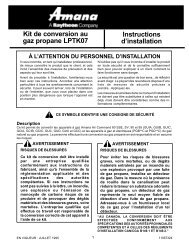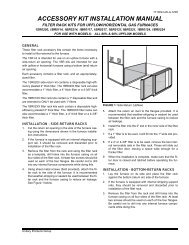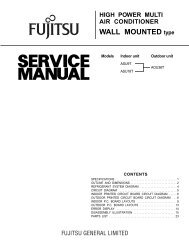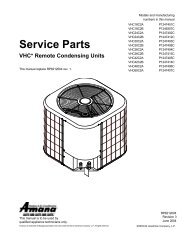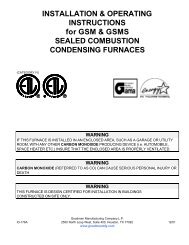INSTALLATION MANUAL
INSTALLATION MANUAL
INSTALLATION MANUAL
You also want an ePaper? Increase the reach of your titles
YUMPU automatically turns print PDFs into web optimized ePapers that Google loves.
167187-UIM-B-0306INSPECTIONAs soon as a unit is received, it should be inspected for possible damageduring transit. If damage is evident, the extent of the damageshould be noted on the carrier’s freight bill. A separate request forinspection by the carrier’s agent should be made in writing. Also, beforeinstallation the unit should be checked for screws or bolts, which mayhave loosened in transit. There are no shipping or spacer bracketswhich need to be removed.FURNACE LOCATION AND CLEARANCESThe furnace shall be located using the following guidelines:1. Where a minimum amount of air intake/vent piping and elbows willbe required.2. As centralized with the air distribution as possible.3. Where adequate combustion air will be available (particularlywhen the appliance is not using outdoor combustion air).4. Where it will not interfere with proper air circulation in the confinedspace.5. Where the outdoor vent terminal will not be blocked or restricted.Refer to “VENT CLEARANCES” located in SECTION VII of theseinstructions. These minimum clearances must be maintained inthe installation.6. Where the unit will be installed in a level position with no morethan 1/4” (6.4 mm) slope side-to-side and front-to-back.Installation in freezing temperatures:1. Furnace shall be installed in an area where ventilation facilitiesprovide for safe limits of ambient temperature under normal operatingconditions. Ambient temperatures may fall below 32° F (0° C)providing the flue temperature does not fall below 260° F (127° C)at any point in the flue pipe between the furnace and the chimneyor a B-Vent. The flue products will condense in the vent pipe if theflue temperature falls below 260° F (127° C) causing the vent pipeto deteriorate rapidly.TABLE 1: Unit Clearances to Combustibles2. Do not allow return air temperature to be below 55º F (13° C) forextended periods. To do so may cause condensation to occur inthe main heat exchanger, leading to premature heat exchangerfailure.Improper installation in an ambient below 32ºF (0.0° C) could createa hazard, resulting in damage, injury or death.3. If this furnace is installed in an unconditioned space and anextended power failure occurs, there will be potential damage tothe internal components. Following a power failure situation, donot operate the unit until inspection and repairs are performed.Clearances for access:Ample clearances should be provided to permit easy access to the unit.The following minimum clearances are recommended:1. Twenty-four (24) inches (61 cm) between the front of the furnaceand an adjacent wall or another appliance, when access isrequired for servicing and cleaning.2. Eighteen (18) inches (46 cm) at the side where access is requiredfor passage to the front when servicing or for inspection orreplacement of flue/vent connections.In all cases, accessibility clearances shall take precedence over clearancesfor combustible materials where accessibility clearances aregreater.Installation in a residential garage:A gas-fired furnace for installation in a residential garage must beinstalled so the burner(s) and the ignition source are located not lessthan 18 inches (46 cm) above the floor, and the furnace must be locatedor protected to avoid physical damage by vehicles.APPLICATIONTOP FRONT REAR LEFT SIDE RIGHT SIDE FLUE FLOOR/In. (cm) In. (cm) In. (cm) In. (cm) In. (cm) In. (cm) BOTTOMCLOSET ALCOVE ATTICLINECONTACTDOWNFLOW 1 (25.4) 6 (15.24) 0 (0.0) 0 (0.0) 3 (7.62) 6 (15.24) 1 (25.4) 1 YES YES YES NODOWNFLOW B-VENT 1 (25.4) 3 (7.62) 0 (0.0) 0 (0.0) 0 (0.0) 1 (25.4) 1 (25.4) 1 YES YES YES NOHORIZONTAL 1 (25.4) 6 (15.24) 0 (0.0) 0 (0.0) 3 (7.62) 6 (15.24) COMBUSTIBLE NO YES YES YES 2HORIZONTAL B-VENT 1 (25.4) 3 (7.62) 0 (0.0) 0 (0.0) 0 (0.0) 1 (25.4) COMBUSTIBLE NO YES YES YES 21. Special floor base or air conditioning coil required for use on combustible floor.2. Line contact only permitted between lines formed by the intersection of the rear panel and side panel (top in horizontal position) of the furnace jacket and building joists, studs or framing.SECTION II: DUCTWORKDUCTWORK GENERAL INFORMATIONThe duct system’s design and installation must:1. Handle an air volume appropriate for the served space and withinthe operating parameters of the furnace specifications.2. Be installed in accordance with standards of NFPA (National FireProtection Association) as outlined in NFPA pamphlets 90A and90B (latest editions) or applicable national, provincial, or state, andlocal fire and safety codes.3. Create a closed duct system. For residential and Modular Homeinstallations, when a furnace is installed so that the supply ductscarry air circulated by the furnace to areas outside the space containingthe furnace, the return air shall also be handled by aduct(s) sealed to the furnace casing and terminating outside thespace containing the furnace.4. Complete a path for heated or cooled air to circulate through theair conditioning and heating equipment and to and from the conditionedspace.When the furnace is used in conjunction with a cooling coil, the coilmust be installed parallel with, or in the supply air side of the furnace toavoid condensation in the primary heat exchanger. When a parallel flowarrangement is used, dampers or other means used to control airflowmust be adequate to prevent chilled air from entering the furnace. Ifmanually operated, the damper must be equipped with means to preventthe furnace or the air conditioner from operating unless the damperis in full heat or cool position.The duct system must be properly sized to obtain the correct airflowfor the furnace size that is being installed.Refer to Table 8 and the furnace rating plate for the correct riserange and static pressuresIf the ducts are undersized, the result will be high duct static pressuresand/or high temperature rises which can result in a heatexchanger OVERHEATING CONDITION. This condition can resultin premature heat exchanger failure, which can result in personalinjury, property damage, or death.The cooling coil must be installed in the supply air duct, downstreamof the furnace. Cooled air may not be passed over the heatexchanger.Unitary Products Group 3



